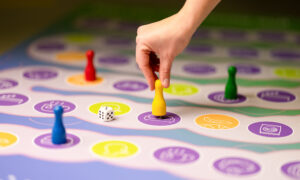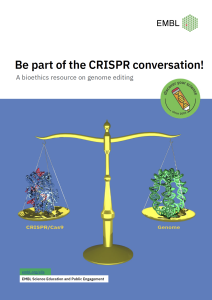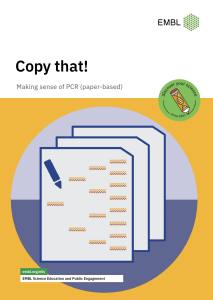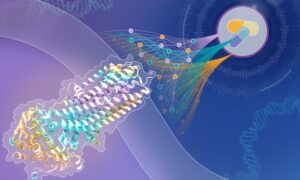
Nexus Island
A game-based teaching resource on the exploration of ecosystems
Introduction
Ecosystems are biological units made up of organisms and the physical environment they inhabit. Within an ecosystem, organisms interact with each other and their environment in a balanced way which ensures the health of this unit. As such, ecosystems are involved in food and energy production and climate regulation. With anthropogenic activities causing the loss of biodiversity at an unprecedented rate, many ecosystems face major challenges in maintaining their healthy balance. Understanding the complex interplay between the living and non-living components of an ecosystem is critical for the preservation and restoration of these habitats, and in effect, maintaining the health of our planet.
The “Nexus Island” teaching resource, inspired by an EMBL-led scientific expedition entitled “TRaversing European Coastlines (TREC)“, invites students to re-evaluate their perception of the environment we live in by focusing on the interaction between living organisms, non-living environmental factors and humans, and their dependencies and adaptation strategies. The game-based approach draws special attention to our ecosystems’ biodiversity, specifically on the microscopic level, and to the extent to which microorganisms are vulnerable to the dynamics of a changing environment. Moreover, the role that research plays in providing data -the basis for any further discussions and actions, is highlighted in relation to analysing each element and organism in the environment.
We hope that you’ll feel inspired to use the game and enjoy discovering the “Nexus Island” ecosystem together with your students.
Overview
“Nexus Island” is a game-based resource focused on ecosystem health. The term “Nexus”, meaning “connection”, hints at the core take-home message of the game: this is an island where everything is connected. Similarly to scientists working in the field, students take part in a scientific voyage to discover the organisms inhabiting the island and explore the connections in place – between the organisms themselves and their environment.
The game is played using the map of the island and game cards and is driven by a narrative leading through the game experience. The island is portrayed on a map divided into four quadrants that represent different habitats with varying degrees of human activity: Nature, City, Agriculture and Industry. A deck of game cards is assigned to each quadrant providing information on the organisms living there. The map shows visual triggers that allow the discovery and identification of the organisms and their characteristics.
The game is composed of three main parts that follow a storyline in which the students are explorers of the island. At the beginning of their expedition, students, in groups, survey the island to discover its inhabitants. Next, students identify the potential impact of an environmental change on the island. Finally, students explore strategies to help restore and maintain the health of the island’s ecosystem.
Game duration: min 90 minutes
Participants: Between 8 and 24 (divided into teams)
Age of participants: 14-16 years old
Game materials: Story, paper prints of the island quadrants, deck of game cards
By playing the game, students will:
- experience being put in the shoes of scientists who study ecosystems and our planet’s health;
- explore their own curiosity towards the natural world
- apply their logical thinking to make observations and predictions;
- communicate and collaborate in a group to discuss problems and find creative solutions;
- get exposed to science as a process to understand the natural world and approach global challenges.
Topics covered
Organisms, sampling, identification & classification, organisms’ ecology, remediation & human intervention, science & society, planetary health
Big Ideas
- Organisms interact with each other, the non-living environment in many different ways.
- Organisms show interdependence with one another and adaptations to their environment.
- Biodiversity describes the variety and variability of organisms in an ecosystem.
- Ecosystems are dynamic structures and their characteristics may change over time.
Prerequisite knowledge
Students are expected to be familiar with concepts like cell biology, energy flow and conversion, homeostasis and response. Understanding ecology concepts such as competition, adaptation and trophic levels might be helpful.
Links to Curriculum
| Curriculum | Content |
| International Baccalaureate | 4.1, 4.2, 4.3 |
| GCSE-AQA | 4.7.1, 4.7.2, 4.7.3, 4.7.4, 4.7.5 |
| AP Biology | 8.2, 8.5, 8.6, 8.7 |
Resource package
The resource package contains the following materials for preparing and playing the game.
Preparing the game
Story
The story is used as a narrative to take students through the game.
Island map
This document contains printable files representing the different quadrants of the island.
Deck of game cards
This document contains printable files of the deck of game cards. Teacher’s guide This guide describes the concept of the game and instructions on how you can use it in class.
Playing the game
Teacher’s guide
This guide describes the concept of the game and instructions on how you can use it in class.
Fact sheets
The fact sheets contain detailed information on the most prominent or abundant organisms on “Nexus Island”, highlighting their roles in energy flow and overall relevance in their ecosystems.
Worksheet & Answer key
The worksheet contains “driving questions” relevant to the different parts of the game and guides the students through the most essential learning aspects of the game. Students can refer to their notes during discussions and you may use them to evaluate their understanding of the information they acquired. For a more immersive and less learning outcome-focused game experience, the worksheets can be omitted.
Game structure
Story
The game is composed of three main parts that are driven by a narrative in the form of a story which aims to facilitate an immersive learning experience. Move to the “Story” section for the full story.
Narrative and game structure
We encourage you to adapt the game to your students’ knowledge and interests. As an optional activity, you may start and end with an association game to probe for students’ perceptions related to ecology and biodiversity.
Optional – Association Game, round 1 (5 minutes)
This short activity can be used as a conversation starter and allow you to understand what associations your students currently have with some concepts related to ecology.
Part 1: Organisms of Nexus Island (30-40 minutes)
Students divide into four teams. Each team explores the island’s ecosystem of one quadrant assigned to them using the game cards.
In this first part of the game students in their teams will:
- Explore the environment and identify all the organisms in their quadrant
- Identify the organism most prevalent in their quadrant
All teams then come together to:
- Outline adaptations that the organisms inhabiting their quadrant display and might have in common with organisms of other quadrants
- Identify whether organisms found in one quadrant are also found in other quadrants and discuss possible reasons why
- Outline the most prevalent organism’s role in the ecosystem of the quadrant
- Identify possible anthropogenic impacts (direct/indirect) on the ecosystem
Part 2: Sudden change in the environment (20 minutes)
In the second part of the game, each team explores how a change in the environmental conditions of the island might affect life in their respective quadrant. The students also evaluate the impact of this change on the organisms. To make informed decisions, students use the information they collected during the first part of the game (noted in their worksheets).
Then, all students gather as a group to discuss their findings. Having in mind that on the “Nexus Island” everything is connected, students are prompted to predict with a reason how and to what extent the whole island has been affected by the sudden change in environmental conditions.
In the second part of the game students in their teams will:
- Evaluate the changes in their quadrant
All teams then come together to:
- Present their findings to the rest of the group
- Outline if and how the island inhabitants are affected by this sudden change in conditions
Part 3: Mitigation efforts to help the ecosystem recover (20 minutes)
In the third part of the game, all students explore measures to mitigate the effects of the sudden environmental change.
In the third part of the game, students will:
- Describe human activities that will have a positive impact on the recovery of the ecosystem following the sudden change
Optional – Association Game, round 2 (5 minutes)
The game can be closed by a second round of the association game. The activity can help identify if and how the students’ association with relevant concepts has changed and if any new knowledge has been picked up.
Materials to download
Nexus Island Resource Package_EnglishNexus Island Resource Package_Bulgarian
Nexus Island Map Full size
Nexus Island Map A3 size
Nexus Island Map A2 size
Nexus Island Game Cards_English
Nexus Island Game Cards_German
Nexus Island Game Cards_Dutch
Nexus Island Game Cards_French
Nexus Island Game Cards_Greek
Nexus Island Game Cards_Italian
Nexus Island Game Cards_Polish
Nexus Island Game Cards_Portuguese
Nexus Island Game Cards_Spanish
Nexus Island Game Cards_Bulgarian
Your feedback
Your feedback on using the “Nexus Island” teaching resource is invaluable to us! Please take a moment to share your thoughts using this link: https://www.surveymonkey.com/r/NI_EN
Thank you for your time and contribution!
Your Feedback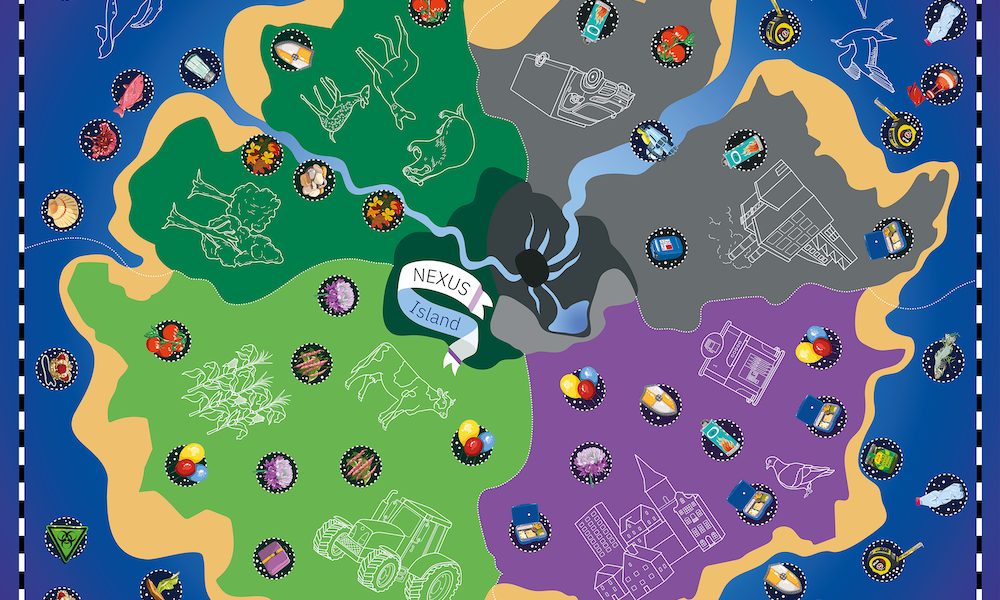
Topic area: Environmental biology
Type of resource: Game-based
Age group: 14-16, 16-19
Contact: SEPE team
Author: SEPE team
Share:
